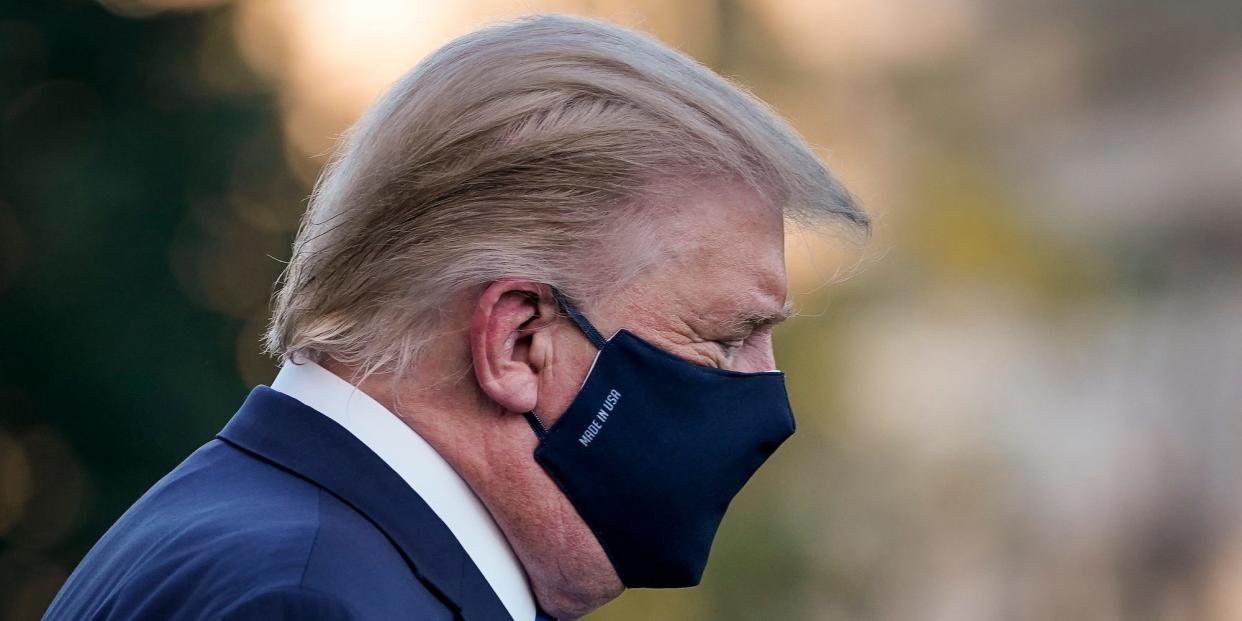Mark Meadows and Dan Scavino 'stared at each other in silence' while sorting out who would carry Trump's 'possibly contaminated' briefcase after his COVID-19 diagnosis: book

Trump was so weak when he contracted COVID-19 that he couldn't carry his briefcase, Meadows wrote in his new book.
Meadows and Dan Scavino "stared at each other" as they decided who would carry the "possibly contaminated" briefcase.
Before contracting COVID-19, Trump repeatedly downplayed the threat of the virus to the public.
When then-President Donald Trump was infected with COVID-19 in September 2020, the disease weakened him to the point where he couldn't carry his briefcase, according to a new book from his former chief of staff, Mark Meadows.
As Trump prepared to depart the White House on October 2, 2020 to board Marine One en route to Walter Reed National Military Medical Center in Bethesda, Maryland, he laid his briefcase on the floor and apologized to Meadows for being unable to carry it, as Meadows details in "The Chief's Chief."
"I'm sorry," Trump reportedly said at the time, according to Meadows. "I-I just can't carry that out there."
Meadows and Dan Scavino, another top aide in the Trump administration, then had to decide who would carry the briefcase.
"We stared at each other in silence for a moment, wondering who was going to pick up the possibly contaminated briefcase. Although I'm sure Dan would have if I had hesitated for a second longer, I ended up being the one to squirt on some hand sanitizer, bend down, and grab it," Meadows wrote.
He continued: "As I walked with President Trump toward Marine One, he looked down at the briefcase in my hand, seemingly impressed."
"'I knew you were my guy,' Trump reportedly told Meadows.
Trump's team did not immediately respond to Insider's request for comment.
In the book, Meadows disclosed Trump's previously unknown September 26 positive test, which came three days before the first in-person debate with then-Democratic presidential nominee Joe Biden in Cleveland, Ohio.
The chief of staff informed Trump of his diagnosis before the debate, but then told Trump that the positive test came from an older-model kit. He also emphasized that another test could be performed with the Binax system. When the second test came back negative, aides thought Trump was in the clear.
But Trump was sicker than the White House had previously revealed, with Meadows noting his visible signs of fatigue between late September and October 1. The then-president publicly announced his diagnosis in the early morning hours of October 2.
Trump contracted the virus after repeatedly downplaying the threat of COVID-19. Throughout much of 2020, Trump consistently refused to follow guidance from top public health experts, such as wearing a mask or face-covering in public, which was recommended for reducing the spread of the coronavirus.
In a recorded interview with veteran journalist Bob Woodward, Trump admitted to deliberately minimizing the dangers of COVID-19.
"I wanted to always play it down," Trump said in March 2020. "I still like playing it down, because I don't want to create a panic."
Over 400,000 Americans had died from COVID-19 — which first emerged in the US in early 2020 — by the time Trump left office in January 2021.
Dr. Deborah Birx, the former White House COVID-19 response coordinator, in her October testimony to the House select subcommittee on the coronavirus crisis, said that over 300,000 lives could've been saved if Trump had publicly emphasized scientific recommendations and embraced measures promoted by experts.
"I believe if we had fully implemented the mask mandates, the reduction in indoor dining, the getting friends and family to understand the risk of gathering in private homes, and we had increased testing, that we probably could have decreased fatalities into the 30% less to 40% less range," Birx said at the time.
Read the original article on Business Insider


